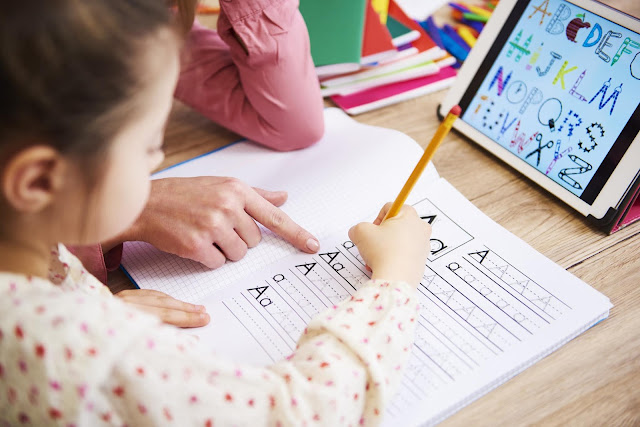Image Credit: gpointstudio/stock.adobe.com
Alphabet posters are excellent tools to incorporate into literacy activities, as children learn letter names, formations, and sounds. Like any anchor chart, alphabet posters shouldn’t be simply put on the wall and forgotten about. Refer to them often so children learn how to use them as a tool to support their learning.
Daily Warm-Up
Alphabet posters can be incorporated into daily literacy lessons, as a warm-up. You could point to letters, out of order, and have children recall their names. The same thing could be done with sounds. In addition to naming the sound, challenge children to think of words that begin with that sound. You could also have children practice forming letters that you point to, using their fingers in the air, or juggling scarves. A quick game to add to your warm-up is to cover up one letter and see if children can guess which one is missing. If your poster pairs letters with pictures, cover up a letter and challenge kids to determine which letter the picture begins with.
Learning Sounds
Alphabet posters help children learn letter sounds when each letter is paired with an object that begins with that sound. For example, the letter “a” could be displayed with an apple or the letter “s” could be shown with a snake. These visual cues are great references when children are learning sounds.
Children can also use alphabet posters as a guide for creating their own posters. Associating letters with words of personal significance may help them remember their sounds. For example, they may associate a sound with the first letter in their name. Or, they may choose a favorite toy or game to pair with a letter. (e.g., pairing “f” with a football) Have children add their own pictures to make personalized posters to refer to when recalling sounds. They can also use items, like gluing buttons next to the letter “b” or grass next to the letter “g.”
Letter Formation
Individual alphabet posters can be laminated or placed in sheet protectors so they can be reused for activities. They lend themselves to many learning activities, as children practice forming the letters of the alphabet. For a kinesthetic experience, they can use materials like playdough, beads, gems, pebbles, or beans to follow the outline of the letter. To practice printing, children can use dry-erase markers to trace the letters.
Writing Center
It is very beneficial for children to have an alphabet poster to refer to any time they are writing. Whether they’re printing their name, labeling a drawing, or writing a sentence, having an alphabet poster that’s easily accessible to them is a valuable anchor chart. Children can check the chart when they are recalling how to form a letter. Sometimes they look to make sure they are using the correct form of the letter - lowercase or uppercase. Alphabet posters are also a useful tool when children are stretching out words they want to write. If they forget a sound, they can use the poster to help cue them. Learning to use anchor charts to support their learning is a valuable strategy that kids can begin developing at an early age.
Matching Game
Alphabet posters can be used to play matching games. For example, give children a letter then ask them to find things around the room that begin with that sound. They may find objects, pictures, or titles of books that match their letter. Another learning activity focuses on matching the upper- and lowercase letters. Point to a letter on the poster then ask them to look around the room to find the upper- or lowercase version of the letter. In addition to letters they find in print, like in books and on signs, it’s great if they also have access to manipulatives like magnetic letters or tiles. Pairing alphabet posters with concrete materials is a helpful way for children to recall letter names and sounds.


No comments :
Post a Comment